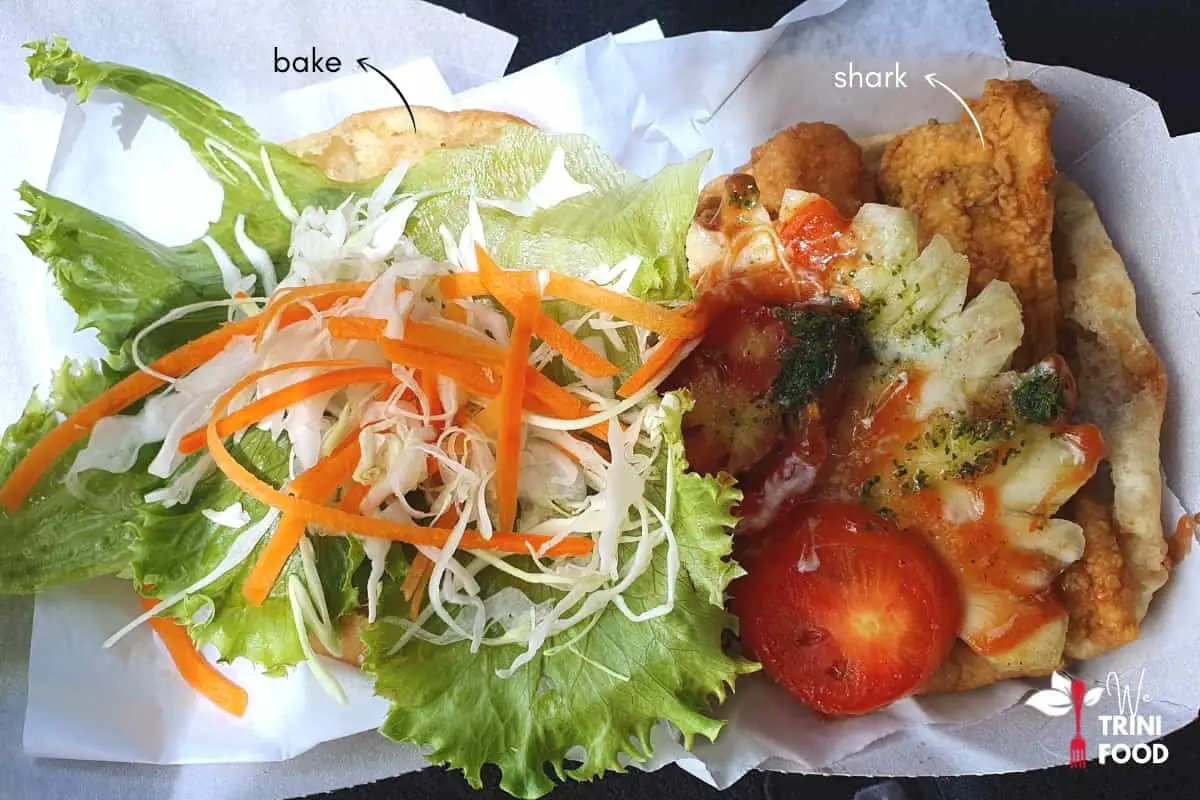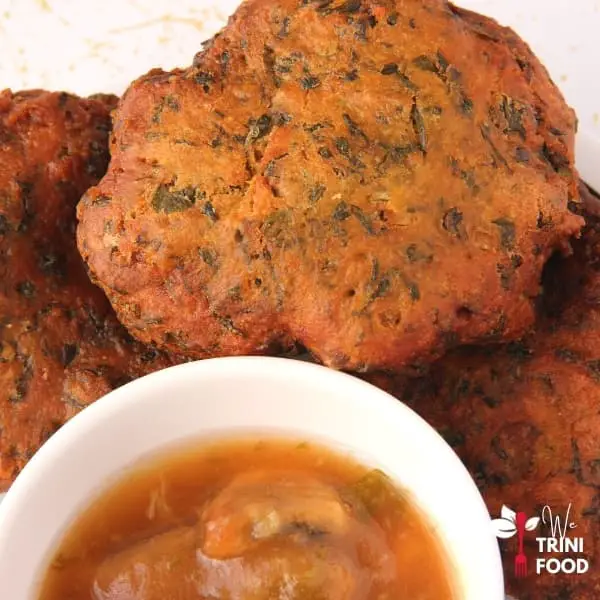Trinidad Breakfast: What Do Trinis Eat for Breakfast
A Trinidadian breakfast is never boring.
From asking the doubles man two with plenty pepper to pouring condiments over your bake and shark, there is something for everyone.
This is by no means an exhaustive list of what Trinis eat for breakfast, but it still is a great place to start.
What makes Trini food special
Trini food is influenced by the cultures of its people – African, East Indian, Chinese, Syrian, and European. And its people had to adapt their recipes to the availability of ingredients in this part of the world. Fusion of cuisines and constant experimentation make Trini food a paradise for foodies and perfectly highlights the uniqueness of Trini culture.
African influences
Africans coming to the Caribbean were human trafficked and brutally tortured. They were given very little to eat, usually salted fish and grains, so they had to plant their own food for sustenance and survival.
They brought across ochro (okra), black eye peas, yam and rice from the continent and used them to supplement their diet. They also used the indigenous foods from the Caribbean like papaya, guava, cassava and roucou and the cheapest cuts of meat like feet and tails.
The Africans had to adapt many of their recipes to these harsh conditions. For instance, they used cassavas to make flour and made dumplings with it.
Many of these adapted recipes are still made to this day… and are constantly evolving.

East Indian influences
Post emancipation of the Africans, East Indians were brought in as laborers. With them came many fruits, vegetables, spices, cooking techniques and names.
Curries, hardi (turmeric), geera (cumin), dhania (coriander), baigan (eggplant), long beans (bodi), mangoes, and many more were introduced to the islands. Curried food, roasted vegetables (choka) and rotis were also added.
These recipes also adapted to the availability of ingredients. For instance, the types of flour used in East Indian cuisine were made from legumes. But, in the Caribbean, wheat flour was available so the texture and taste of the rotis changed.
Similarly, the taste profiles of the curries and spices changed to include new flavors like chadon beni (culantro or bandhania).

Ongoing fusion and experiments
With time and greater integration, Trinidadian food has changed in many ways.
Cheap street foods are now widely accepted and favored among all Trinbagonians. Such popularity has sparked new ways to add flavor. For instance, sauces like chadon beni and tamarind sweet sauce are optional toppings for doubles and bake and shark.
Curry-stew meats are another classic example of fusion. Stewing is an African cooking technique and curries are from Indian cuisine. Merging the two flavor profiles produces an amazing final meat dish. Trust me!
With the creativity of the people, you will always find some new recipe or food to try.
What do Trinis eat for breakfast
For breakfast, Trinis enjoy fried street food like doubles, aloo pie, and bake and shark, buljol or smoked herring. Sada roti and chokas, curries, bhagi, and fried vegetables are eaten regularly. Coconut bake and cheese, butter, fish, meat or vegetable fillings are also quite popular. Of course, English and American foods like pancakes, waffles, eggs, sausage, bacon, oatmeal and muffins are often enjoyed as well.
Let’s break it down a little more.
Doubles
Doubles is one of the most popular street foods in T&T. It consists of two thin ‘baras’ topped with seasoned channa (chickpeas) and a wide range of condiments. Recipe >> here.

Doubles bara is a flat, deep fried dough often made with flour, yeast, sugar, salt and turmeric powder. The turmeric powder colors the bara. Bara with ground urdi is much less common, but still tasty too.
Doubles channa contains channa (chickpeas), dhal (yellow split peas), baking soda, Caribbean green seasoning, geera (cumin), turmeric and pepper. Once fully cooked, you’ll get a thick, tasty chickpea dish to add on top of the bara.
The condiments used on the channa can be cucumber chutney, coconut chutney, tamarind sweet sauce, chadon beni sauce, pepper sauce, roasted pepper sauce and more.
Although, individually, bara and channa are rooted in East Indian cuisine, together as doubles, they are considered a Trini dish.
Doubles is served on wax paper and eaten with your hands. The bara is torn and used as a scoop for the channa and condiments.
Here’s a really nice video showing doubles vendors, a little history and more:
Fry bake and sides
Bake and shark is another popular street food in T&T and is especially enjoyed at Maracas Beach.
My bake and shark are hidden underneath all my toppings here:

Fry bake is a flattened dough that puffs up nicely when deep fried. The dough is made with simple ingredients like flour, raising agents, and butter. Check out my trini fry bake recipe.
Cutting along the fry bake will give you a wonderful pocket to add any type of tasty filling and condiments. Fried shark, king fish and shrimp are wonderful fried additions. Prepared sardines or buljol made with smoked herring or salt fish are also favorites.
Fry bake is enjoyed as a sandwich.
Here’s a great behind-the-scenes look at making bake and shark:
By the way, saltfish buljol is made by soaking and boiling the fish to remove all that salt. Then, it is shredded and mixed in with fried onions, tomatoes and pepper.
Oh and be sure to stop by my fried shark bites recipe.
Sada roti and sides
Sada roti is one of the more popular breakfast foods made at home.
It is made with flour and baking powder, and is rolled out and cooked on a hot tawa or a smooth, flat griddle. As it cooks, the roti puffs up and creates a wonderful pocket. The circular roti is removed from the heat and cut into quarters before serving alongside mostly vegetable side dishes.
Check out my sada roti recipe here plus tips for making sure it is soft and swells.
Tomato, baigan (eggplant) and aloo (potato) chokas are most often served with sada roti. Curry bodi (long beans), fry bodi, fry aloo, fry ochro (okra), fried plantains, pumpkin talkari, dasheen bhagi, chori bhagi, zaboca (avocado) and even cheese are other options to serve with sada roti.
Here’s a recent photo of my Saturday morning breakfast: sada roti and tomato choka:

Dosti roti is another type of roti served with these sides, but is not as popular as sada roti.
I have lots of these recipes on my blog, so be sure to check them out.
Roti is a traditional Indian dish that was cooked in a chulha (mud wood burning stove) long ago. My parents grew up making their rotis this way. Here’s Shanty showing the old-time way:
Aloo pie and fried Indian treats
Besides doubles, aloo pies, saheenas, kachoris and baiganies are also enjoyed for breakfast with seasoned channa (chickpeas), chutneys and sauces like tamarind sauce.
Aloo pie is a deep fried dough that has been stuffed with aloo (potato) seasoned with Caribbean green seasoning, geera (cumin) and other spices.

Saheena is another deep fried Indian delicacy made with dasheen (taro) leaves, dhal (split peas powder) channa (chickpea) flour and lots of fresh seasonings. There are two ways to make saheena – with rolled up dasheen leaves or with finely chopped leaves.

Like the other two, kachori is a deep fried Indian street food made with channa (chickpeas), dhal (split peas), flour and seasonings.

Baiganie is made with baigan (eggplant) that has been battered and deep fried. The batter varies from a flour-based one to a kachori type of batter.

As I said before, fusion and experimentation are part of Trini cooking. So, there are new variations like dhal pie, baigan saheena and so much more.
Dhal pie is made much in the same way as aloo pie, except the stuffing used is yellow split peas (dhal). Baigan saheena is made by dipping a slice of eggplant into the saheena batter before frying.
There is no shortage of food experimentation and ingenuity in T&T.
Coconut bake and sides
Unlike fry bake, coconut bake is more bread-like. It is made with flour, raising agent (yeast or baking powder), freshly grated coconut and butter and shaped into a large circular dough. When baked, it smells amazing and has such a wonderful coconut flavor.
Coconut bake is served with many sides ranging from saltfish buljol, sardines, cheese, butter, steamed vegetables and so much more.
Check out my soft, homemade coconut bake recipe here.
Pies with flaky pastry
Everyone has their favorite pie man. Flaky pastry pies are easy, on-the-go foods especially for breakfast and brunch. It is made the same way as flaky pastries and is stuffed with many fillings from cheese and bhagi (spinach) to chicken and tuna. The pies taste really good!
So much more options
With the abundance of Trinidad and Tobago fruits on the islands, a delicious fruit platter is a nice, healthy Trini breakfast. Seasonal fruits like mango and pomerac are great alongside all-year fruits like pineapple, papaya, and bananas.
As I mentioned before, American and English breakfast options are also enjoyed on the islands. Pancakes, muffins, sausages, bacon, potatoes, baked beans, eggs and oatmeal are delicious choices.
It’s fair to say a Trinidad breakfast has something for everyone – from picky eaters and vegans to adventurous foodies.
What is your favorite?


Work my ass off saved and come Trini, no hotel, found a bed after couple days, all over N E S W your country on bus, maxi and route taxi, what a great people I was meeting, real people like me, decent, moral, honest, generous, fun and lend hand, I cried when I left, and breakfast? Best I’ve ever had,cos I was on strict money, breakfast last me all day in my belly, Love Trinidad X